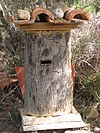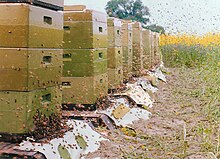Beehive
A beehive is an artificial nesting cavity (dwelling) made available by the beekeeper, together with the honey bees in it. The dwelling alone is called prey . Modern magazine hives consist of one or more so-called frames placed on top of one another (boxes open at the top and bottom) as well as a removable lid and a wooden or plastic base .
Term prey
The word booty was first used in the 8th century for a baking board or a baking trough and later for the forest beehive. Despite the early evidence, neither the origin nor the history is sufficiently clear. The Middle High German word "biuta" is attested as a beehive and the Old High German "biutte" or "biot" as a baking trough or beehive. Originally, the word “prey” often referred to the entire beehive tree in this context. The first German author of a book on beekeeping, Nickel Jacob , who was born in Sprottau in 1505, coined the term prey in early specialist literature. It was not until the 19th century that this term became established as a term for a bee dwelling made available by humans.
history
By nature, the European subspecies of the western honey bee need winter and weatherproof housing to survive. A nest box with a size of about 60 liters, which is dry all year round, is suitable for this. Originally the bees lived wild in naturally occurring tree hollows in the forest. In the early days, humans began to offer bees hollowed out tree trunks or other hollow spaces as nesting sites. Hollowed-out cylindrical logs, primarily of the Sūkam tree, are still used in Yemen . Clay tubes are also used in Africa. In Western Europe, people imitated hollow tree trunks with log hives or log dummies , which they offered bees to nest. The same function was fulfilled by woven rod covers or woven straw baskets . Special types and forms of bee housing made of different materials developed everywhere. In Carinthia they were called the Kärntner Bauernstock and Krainer Bauernstock . Wayside shrines are called logs made of logs that are richly carved and painted. In their exterior they are more like carved wooden statues than a bee dwelling.
The disadvantage of all these dwellings was that honey can only be harvested by cutting out part of the honeycomb structure of the bees and thus destroying them. Because of the honeycomb structure firmly attached to the hive, the type of honeycomb is known as a stable structure.
In large parts of Asia, the eastern honeybees were and are still being kept in rural areas in log hives or hollows in walls as the “bees of the little man”.
Currently common apiary
In the 19th century came through honeycomb in movable wooden frames of Mobilbau on. That was a hive made of wood that the beekeeper worked from behind. Compared to wild beekeeping, their flexible honeycomb structure represents a significant advance in beekeeping. The honeycombs are placed in frames in the hive. This means that the honeycombs filled with honey can be removed and replaced with other empty ones (ejected). In this way, the bees have to spend less energy building new honeycombs. Another advantage is that such hives can be easily housed in an apiary or a beehive . In the heather apiary, the straw baskets were set up in bee fences . A modern alternative to these meanwhile less common modes of operation is beekeeping with magazine hives (see photo above), which are set up freely in the area without any further protection. Since magazines can only be processed from above, the magazine spoil is an upper treatment spoil. Global beekeeping only works in magazine hives in the 21st century. Germany is divided into north and south within the magazine beekeeping. While the Segeberger hives made of plastic (rigid foam polystyrene ), developed in the Bad Segeberg beekeeping school, are predominantly used in the north, although this excludes certification as organic honey, in the south, wooden hives are more common. The trend towards magazine emerged in the 1970s. Before that, there were mainly wooden hives that were placed in apiaries throughout Germany. This type of hive and placement (also in beehives) was mostly common in East Germany in the GDR until the turn of 1989. Mobile construction without a frame is possible with the Top-bar hive .
Depending on the position of the honeycombs in the beehive, a distinction is made between cold and warm construction. If the honeycombs are parallel to the entrance hole, it is a cold construction. If, on the other hand, the honeycomb is perpendicular to the entrance hole, it is referred to as warm construction. However, beekeepers are still not in agreement about which construction is the "better" one.
List of prey types
| Type | Emergence | comment | image |
|---|---|---|---|
| Log booty | Hollow tree trunk, one of the oldest hives |

|
|
| Beehive | Made of woven straw |

|
|
| Horizontal prey |

|
||
| Krainer stick | 18th century | Shape of the horizontal hive |

|
| Aftertreatment prey |

|
||
| Bullet loot | around 2012 | Research subject of the University of Würzburg
|
|
| Magazine loot | Dominant form |

|
|
| Erlanger magazine loot | from 1911 | Shape of the magazine loot | |
| Top bar hive |

|
||
| Upper carrier prey |

|
||
| One-room booty | |||
| Bee box | |||
| Beehive |
Beehive as a symbol
In the early days of Christianity , bees were considered a symbol of order, obedience and chastity. People believed that the bees would collect their brood on certain plants since the queen bee mating was not yet known. The bee thus became a symbol of the virginity of Mary . In Christian art, the beehive is an attribute of St. Ambrose of Milan . It stands for the gift of eloquence, which, according to legend, Ambrose was bestowed as a newborn by a swarm of bees who sat on his face and dripped honey into his mouth. Also, St. Bernard , the doctor Mellifluus (honey flowing scholar) is occasionally presented with a beehive. Bettina Vaupel from the German Foundation for Monument Protection describes in her article "What does the beehive stand for" that his fluency is said to have been so great that the words "smooth as honey" from his "rousing sermons" should have flowed out of his mouth.
But the beehive also found its way into art. For example, Johann Baptist Enderle painted the dining room in the rectory in Zaisertshofen around 1770 . In the corner cartouches he painted, among other things, beehives and the saying “sic vos, non vobis” (You are like that, nothing belongs to you) as a reminder to live modestly.
See also
Web links
Individual evidence
- ^ Hermann Pechhacker: The global bee trade and its consequences. (MS Word file; 35 kB). Institute for Apiculture, Lunz am See.
- ↑ When is honey organic? Bayerischer Rundfunk, accessed June 30, 2019 .
- ^ The ball of bees - W for knowledge - ARD. In: daserste.de. Retrieved February 12, 2016 .
- ↑ Bionics of the bee ball. In: bienenkugel.de. Retrieved January 15, 2017 .
- ↑ One-room booty Mellifera. Retrieved July 20, 2020 .
- ↑ Bee box, a home for bees. Stadtbienen.org, accessed on August 20, 2020 .
- ↑ The beehive. Retrieved August 10, 2020 .
- ↑ Bettina Vaupel: What does the beehive stand for? In: Monuments , 2020, no. 2, p. 18 f.



